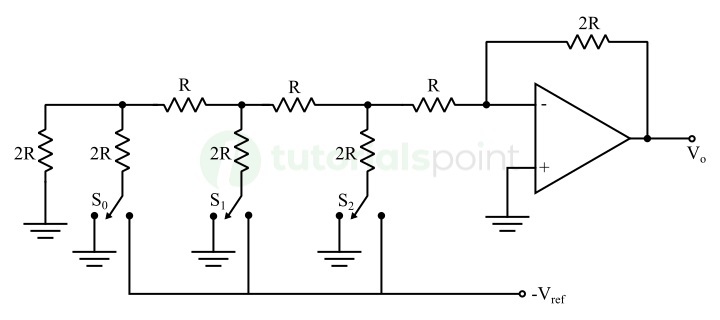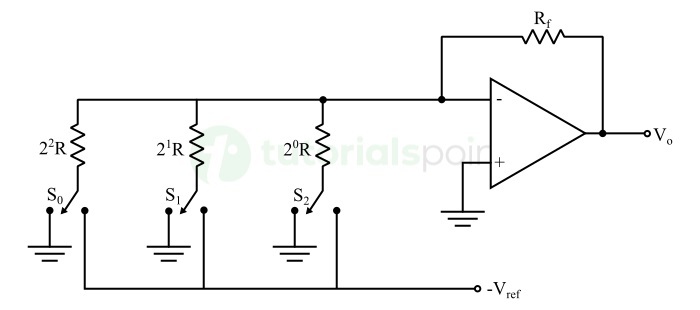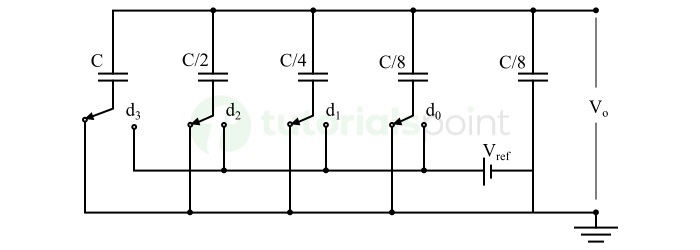
 Data Structure
Data Structure Networking
Networking RDBMS
RDBMS Operating System
Operating System Java
Java MS Excel
MS Excel iOS
iOS HTML
HTML CSS
CSS Android
Android Python
Python C Programming
C Programming C++
C++ C#
C# MongoDB
MongoDB MySQL
MySQL Javascript
Javascript PHP
PHP
- Selected Reading
- UPSC IAS Exams Notes
- Developer's Best Practices
- Questions and Answers
- Effective Resume Writing
- HR Interview Questions
- Computer Glossary
- Who is Who
Bipolar-Output D/A Converters
In digital electronics, a D/A converter, also called Digital-to-Analog Converter, is an electronic device that converts digital signal inputs into analog signal outputs. Depending on the polarity of output signals, D/A converters can be classified into two types namely, Unipolar-Output D/A Converters and Bipolar-Output D/A Converters.
A unipolar-output D/A converter can produce only positive analog signals as output, whereas a bipolar-output D/A converter can produce both positive and negative analog signals as output.
In this tutorial, we will discuss bipolar-output D/A converts, along with their construction, types, working, advantages, and applications. So, let's start with the basic definition of bipolar-output D/A converter.
What is a Bipolar-Output D/A Converter?
An electronic device or circuit that can convert digital signals into analog signals and can represent both positive and negative values of output analog signals is referred to as a bipolar output D/A converter.
Bipolar-output D/A converters are mainly used in control systems, telecommunication systems, audio signal processing, etc.
There are various techniques used in bipolar-output D/A converters to produce both positive and negative analog signal outputs. One most commonly used technique utilizes a combination of Op-Amps, switches, and resistors to convert digital signals into analog signals.
The greatest advantage of bipolar-output D/A converters is that they can accurately represent digital information in the form of continuous analog signals.
Types of Bipolar-Output D/A Converters
Based on the architecture, there are following four types of bipolar-output D/A converters:
R-2R Ladder D/A Converter
Binary Weighted D/A Converter
Sigma-Delta D/A Converter
Switched-Capacitor D/A Converter
R-2R Ladder D/A Converter
The circuit diagram of an R-2R ladder D/A converter is shown in the following figure.

The R-2R ladder is one of the most commonly used architectures for bipolar-output D/A converters. In this type of bipolar-output D/A converter, a network of precision resistors in a ladder like structure is developed, and a digital signal input is applied to this ladder network. The converted bipolar analog signal is obtained at the output.
The major advantage of R-2R ladder D/A converter is its high accuracy and linearity.
Binary Weighted D/A Converter
The construction of a binary weighted D/A converter is shown in the following figure.

This type of bipolar-output D/A converter consists of a resistive network with different weights depending on the binary value of the input digital signal. The switching of these resistors is done based on bits of the digital signal input. Thus, this circuit will produce a corresponding analog signal at output.
The major advantage of binary-weighted D/A converter is its high-speed operation, but it has a limitation in resolution due to requirements of the resistor matching.
Sigma-Delta D/A Converter
The construction of a sigma-delta bipolar D/A converter is shown in the following figure.

A sigma-delta D/A converter first converts the digital signal input into a high-frequency bit-stream, and then filter and integrate the bit-stream to produce an analog output.
This type of bipolar-output D/A converter employs over sampling and noise shaping techniques to convert a digital signal input into an analog signal output. This allows to achieve higher resolution and better performance. The sigma-delta D/A converters are mainly used in audio processing, as they provide high linearity and dynamic range.
Switched Capacitor D/A Converter
The circuit diagram of a switched capacitor D/A converter is depicted in the following figure.

In this type of bipolar-output D/A converter, a combination of capacitors and switches is used to convert a digital signal input into an analog signal output.
The switched capacitor DAC first samples and holds digital signal input, and then open or close switches to provide different configurations of capacitors depending on the digital signal input.
This type of D/A converters are primarily used in ICs (Integrated Circuits) and provide high accuracy and linearity.
Characteristics of Bipolar-Output D/A Converters
The following are some important factors that must be considered while working with bipolar output D/A converters:
Speed - The speed of converter must justify the requirements of the application.
Resolution - The resolution of converter is determined by the number of bits in digital input signal. It influences the accuracy of the analog signal output.
Linearity - The converter must have a good linearity, so it can accurately represent a digital signal in analog form.
Accuracy - The accuracy of the analog signal output must be carefully determined.
Advantages of Bipolar Output D/A Converter
The important advantages of bipolar output D/A converter are listed below:
A bipolar output D/A converter is capable of representing both positive and negative values of the analog signal output.
Bipolar output D/A converter provides an extended signal range, as it can support both positive and negative values.
It provides higher flexibility and accuracy in representing the values of analog signal output.
Bipolar output D/A converters can be directly used with the bipolar systems without need for additional interfacing components.
Bipolar output D/A converters are efficient in generating balanced symmetric waveforms of signals.
Bipolar output D/A converters provide enhanced linearity and reduced signal distortion.
Limitations of Bipolar Output D/A Converters
The following are some major limitations of bipolar output D/A converters:
Bipolar output D/A converters have complex circuit design, as it requires additional components to handle negative values.
Bipolar output D/A converters have more number of electronic components and hence more power consumption.
Bipolar output D/A converters are more expensive than unipolar converters.
Applications of Bipolar Output D/A Converters
Bipolar output D/A converters are widely used in different fields of engineering and technology where both positive and negative analog signals are required for processing. A few common examples of applications of bipolar output D/A converters are listed below:
Bipolar output D/A converters are widely used in various audio processing applications like in audio playback systems, digital audio interfaces, audio synthesis, reproduction of audio signals, etc.
Bipolar output D/A converters are also used in communication systems to perform signal modulation.
Bipolar output D/A converter is also used in industrial control systems, such as in robotics, motor drives, automation and process control, etc.
Bipolar output D/A converters also find applications in graphics display units to display images with accurately.
Bipolar output D/A converters are also used to control bidirectional operation of electric motors in robotics, electric vehicles, industrial automation, etc.
Conclusion
In conclusion, a bipolar output D/A converter is an electronic circuit that can convert a digital input signal into an analog output signal with both positive and negative values. Hence, bipolar-output D/A converters provide greater flexibility in representing digital information in the form of continuous analog signals. These converters are widely used in audio signal processing, communication systems, industrial control systems, robotics, etc.

